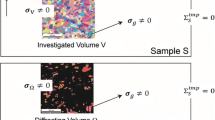Abstract
Residual elastic strains in a bent bar of titanium alloy Ti-6Al-4V were measured using high energy diffraction on station 16.3 at SRS Daresbury. Using a single bounce Laue crystal monochromator, diffraction peaks were collected for reflections (00.2), (10.1), (10.2) and (11.0) from the hcp alpha phase of the titanium alloy. Reference values of the lattice spacing for each of the reflections were found from the diffraction pattern collected from a stress-free sampling volume. The residual elastic strain values calculated on the basis of each reflection were then computed and plotted as a function of position across the bent bar. The average macroscopic residual elastic strain was computed using an averaging procedure taking into account the multiplicity of each reflection. Energy dispersive white beam diffraction from the same bent bar was used to collect diffraction patterns over the range of lattice spacings between 0.8 and 2.2 Å. Detector calibration was carried out using the procedure described in Liu et al. (2005) and detailed interpretation of the energy dispersive profiles was carried out allowing the identification of average residual elastic strains in the two principal phases present in the titanium alloy considered, the α-Ti hcp and the β-Ti bcc phases. Peak-specific residual strain profiles computed on the basis of monochromatic measurements show significant differences reflecting the variation in the elastic and plastic properties with grain orientation, i.e., crystal anisotropy. Using the contrast between the elastic and plastic properties of different directions within the α-Ti hcp lattice, the difference between residual elastic strains measured for (00.2) and (11.0) reflections was plotted, as well as the ‘difference strain’ between (00.2) and (10.1) reflections. These profiles show a good qualitative correlation with the plastic strain profile introduced by inelastic bending that was computed from the analysis of Pawley refinement of the energy-dispersive diffraction measurements.
Similar content being viewed by others
References
Ballirano P, Caminiti R (2001, Dec) Rietveld refinements on laboratory energy dispersive X-ray diffraction (EDXD) data. J Appl Crystallogr 34:757–762.
Busso EP, Cailletaud G, Dunne F (2001) Special issue on: micro–macro links in advanced constitutive formulations. Int J Plast 17:409–410.
Clausen B, Lorentzen T, Bourke MAM, Daymond MR (1999, Jan) Lattice strain evolution during uniaxial tensile loading of stainless steel. Mater Sci Eng A Struct Mater Prop Microstruct Process 259:17–24.
Collins SP, Cernik RJ, Fell B, Tang CC, Harris NW, Miller MC, Oszlanyi G (1998, Sep) Station 16.3: a high-resolution single-crystal diffraction facility at the SRS, Daresbury. J Synchrotron Radiat 5:1263–1269.
Cullity BD, Stock SR (2003) Elements of X-Ray Diffraction. Prentice-Hall.
Dawson P, Boyce D, MacEwen S, Rogge R (2000, Jun) Residual strains in HY100 polycrystals: comparisons of experiments and simulations. Metall Mater Trans A Phys Metall Mater Sci 31:1543–1555.
Daymond MR (2004, Oct) The determination of a continuum mechanics equivalent elastic strain from the analysis of multiple diffraction peaks. J Appl Phys 4263–4272.
Dong YH, Liu J, Li YC, Li XD (2003, Oct) A full-pattern fitting algorithm for energy-dispersive X-ray diffraction. JAppl Crystallogr 1123–1127.
Han TS, Dawson PR (2005, Sep) Lattice strain partitioning in a two-phase alloy and its redistribution upon yielding. Mater Sci Eng A Struct Mater Prop Microstruct Process 405:18–33.
Hauk V (1997) Structural and Residual Stress Analysis by Nondestructive Testing: Evaluation–Application–Assessment. Elsevier, Oxford.
Hutchinson JW (1970) Elastic-plastic behaviour of polycrystalline metals and composites. Proc R Soc Lond A Math Phys Sci 319:247.
Korsunsky AM, Collins SP, Owen RA, Daymond MR, Achtioui S, James KE (2002) Fast residual stress mapping using energy-dispersive synchrotron X-ray diffraction on station 16.3 at the SRS. J Synchrotron Radiat 9:77–81.
Korsunsky AM, Daymond MR, James KE (2002) The correlation between plastic strain and anisotropy strain in aluminium alloy polycrystals. Mater Sci Eng A Struct Mater Prop Microstruct Process 334:41–48.
Korsunsky AM, Jarnes KE, Daymond MR (2004) Intergranular stresses in polycrystalline fatigue: diffraction measurement and self-consistent modeling. Eng Fract Mech 71:805–812.
Korsunsky AM (2005) On the modelling of residual stresses due to surface peening using eigenstrain distributions. J Strain Anal Eng Des 40:817–824.
Korsunsky AM (2006, Feb) Variational eigenstrain analysis of synchrotron diffraction measurements of residual elastic strain in a bent titanium alloy bar. J Mech Mater Struct 1.
Larson AC, Von Dreele RB (2000) General Structure Analysis System (GSAS) Los Alamos National Laboratory Report LAUR 86–748.
Laundy D, Lennie A, Golshan M, Taylor D, Roberts M, Bushnell-Wye G, Cernik RJ, Flaherty J, Burrows I (2004) AIP Conference Proceedings 683.
Liu J, Kim K, Golshan M, Laundy D, Korsunsky AM (2005) Energy calibration and full-pattern refinement for strain analysis using energy-dispersive and monochromatic X-ray diffraction. J Appl Crystallogr 38:661–667.
Noyan IC, Cohen JB (1987) Residual Stress: Measurement by Diffraction and Interpretation. Springer, Berlin Heidelberg New York.
Pawley GS (1981, Dec) Unit-cell refinement from powder diffraction scans. J Appl Crystallogr 14:357–361.
Sachs G (1928) Zur Ableitung einer Fleissbedingung. Z Ver Dtsch Ing 72:734–736.
Schmid E, Boas W (1935) Kristallplastizität. Springer, Berlin Heidelberg New York.
Steuwer A, Santisteban JR, Turski M, Withers PJ, Buslaps T (2004, Dec) High-resolution strain mapping in bulk samples using full-profile analysis of energy-dispersive synchrotron X-ray diffraction data. J Appl Crystallogr 37:883–889.
Toby BH (2001) EXPGUI, a graphical user interface for GSAS. J Appl Crystallogr 34:210–221.
Turner PA, Tomé CN, Woo CH (1994, Oct) Self-consistent modeling of nonlinear viscoelastic polycrystals—an approximate scheme. Philos Mag A Phys Condens Matter Struct Defects Mech Prop 70:689–711.
Author information
Authors and Affiliations
Corresponding author
Rights and permissions
About this article
Cite this article
Korsunsky, A.M., Liu, J., Golshan, M. et al. Measurement of Residual Elastic Strains in a Titanium Alloy Using High Energy Synchrotron X-Ray Diffraction. Exp Mech 46, 519–529 (2006). https://doi.org/10.1007/s11340-006-8250-2
Received:
Accepted:
Published:
Issue Date:
DOI: https://doi.org/10.1007/s11340-006-8250-2




